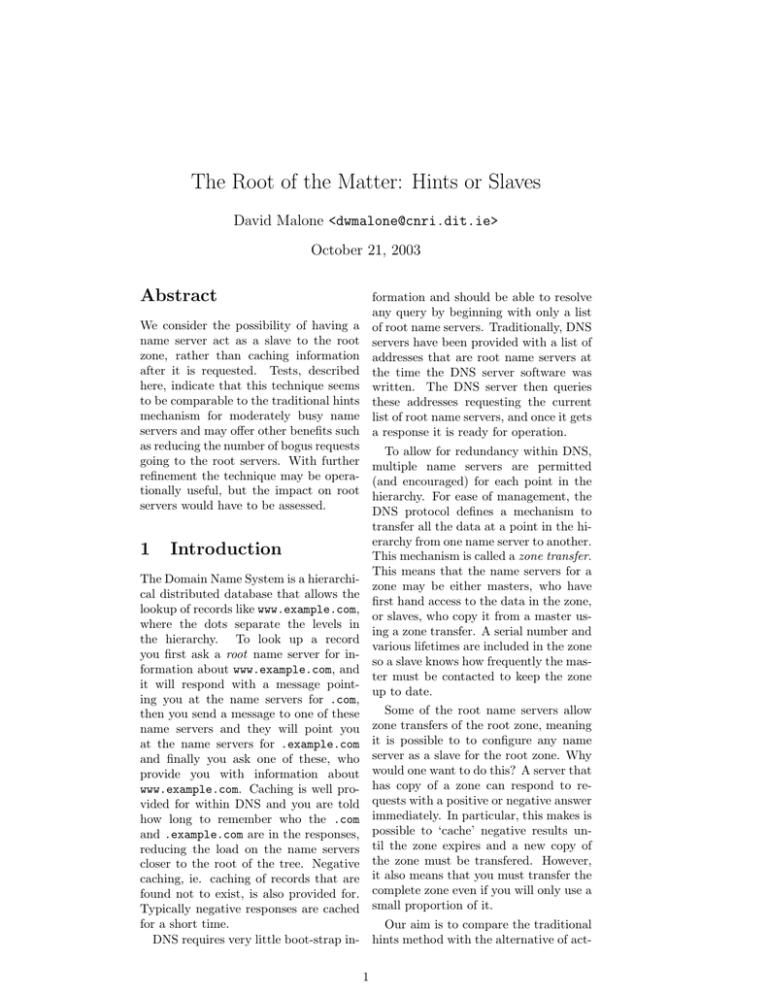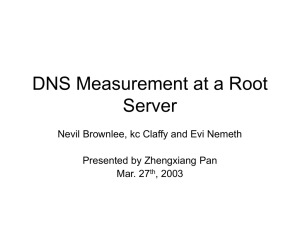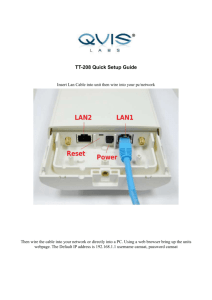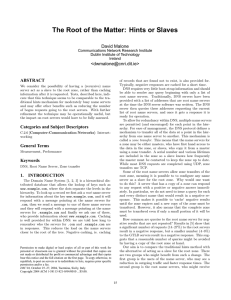The Root of the Matter: Hints or Slaves Abstract David Malone <>
advertisement

The Root of the Matter: Hints or Slaves
David Malone <dwmalone@cnri.dit.ie>
October 21, 2003
Abstract
formation and should be able to resolve
any query by beginning with only a list
of root name servers. Traditionally, DNS
servers have been provided with a list of
addresses that are root name servers at
the time the DNS server software was
written. The DNS server then queries
these addresses requesting the current
list of root name servers, and once it gets
a response it is ready for operation.
We consider the possibility of having a
name server act as a slave to the root
zone, rather than caching information
after it is requested. Tests, described
here, indicate that this technique seems
to be comparable to the traditional hints
mechanism for moderately busy name
servers and may offer other benefits such
as reducing the number of bogus requests
going to the root servers. With further
refinement the technique may be operationally useful, but the impact on root
servers would have to be assessed.
1
To allow for redundancy within DNS,
multiple name servers are permitted
(and encouraged) for each point in the
hierarchy. For ease of management, the
DNS protocol defines a mechanism to
transfer all the data at a point in the hierarchy from one name server to another.
This mechanism is called a zone transfer.
This means that the name servers for a
zone may be either masters, who have
first hand access to the data in the zone,
or slaves, who copy it from a master using a zone transfer. A serial number and
various lifetimes are included in the zone
so a slave knows how frequently the master must be contacted to keep the zone
up to date.
Introduction
The Domain Name System is a hierarchical distributed database that allows the
lookup of records like www.example.com,
where the dots separate the levels in
the hierarchy. To look up a record
you first ask a root name server for information about www.example.com, and
it will respond with a message pointing you at the name servers for .com,
then you send a message to one of these
name servers and they will point you
at the name servers for .example.com
and finally you ask one of these, who
provide you with information about
www.example.com. Caching is well provided for within DNS and you are told
how long to remember who the .com
and .example.com are in the responses,
reducing the load on the name servers
closer to the root of the tree. Negative
caching, ie. caching of records that are
found not to exist, is also provided for.
Typically negative responses are cached
for a short time.
DNS requires very little boot-strap in-
Some of the root name servers allow
zone transfers of the root zone, meaning
it is possible to to configure any name
server as a slave for the root zone. Why
would one want to do this? A server that
has copy of a zone can respond to requests with a positive or negative answer
immediately. In particular, this makes is
possible to ‘cache’ negative results until the zone expires and a new copy of
the zone must be transfered. However,
it also means that you must transfer the
complete zone even if you will only use a
small proportion of it.
Our aim is to compare the traditional
hints method with the alternative of act1
ing as a slave for the root zone. There #!/bin/sh
are two groups who might benefit from tcpdump -p -i fxp1 -n \
-w SERVER-‘date +%Y%m%d%H%M%S‘ \
such a change. The first group is the
’host SERVER_IP and \
users of the name server who may see a
port 53 and \
reduction in outgoing traffic and faster
( host 198.41.0.4 \
response times. The second group is the
or host 128.9.0.107 \
root name servers themselves, who might
or host 192.33.4.12 \
be receive less queries. Evidence already
or host 128.8.10.90 \
suggests that much of the traffic to the
or host 192.203.230.10 \
root name servers is in some way boor host 192.5.5.241 \
gus and that if the bogus queries can be
or host 192.112.36.4 \
stopped at the local name server, that
or host 128.63.2.53 \
may be useful.
or host 192.36.148.17 \
or host 192.58.128.30 \
or host 193.0.14.129 \
2 Setup
or host 198.32.64.12 \
or host 202.12.27.33 )’
Our method is to monitor the traffic
from two name servers to the root name
servers over the period of two week. At
Figure 1: Tcpdump parameters used for
the end of the week we change the name
recording DNS traffic
servers from the traditional hints method
to be slaves for the root zone.
zone "." {
The two DNS servers were both runtype hint;
ning FreeBSD 4 and the name server
file "root.cache";
software was BIND 9.2.1.
};
The first DNS server is used by a small
research group of 10–20 people. It serves
a quiet mail and web server and the Figure 2: BIND 9 config for hinting root
workstations of the research group. We zone
refer to this server as the quiet server.
The other DNS server is busy, acting
DNS traffic from both systems was colas a name server to an academic departlected
using tcpdump starting on Tuesment providing Unix services to 1000 unday
28
January 2003 and Tuesday 2
dergraduates, postgraduates and staff,
February
2003. Traffic from the quiet
including a mail server, a web cache, a
system
was
collected by running tcpweb server and an anonymous ftp server.
dump
on
that
system. Traffic from the
These services will generate quite a high
busy
system
was
collected by running
DNS load because the web server and
tcpdump
on
a
router
that sees all exterTCP wrappers have been configured to
nal
traffic.
The
tcpdump
command line
do forward and reverse lookups for most
is
shown
in
Figure
1.
The
name server
connections. The name server also acts
on
both
hosts
was
restarted
as measureas a primary or secondary server for
ments
began
on
both
Tuesdays
to enaround 70 zones in each of two ‘views’.
sure
the
nameserver’s
cache
was
starting
This network also has IPv6 connectivity,
the mail and web server are IPv6 capa- empty.
For the first week, both servers used
ble, though the web cache is not. We
the
traditional hints mechanism configrefer to this server as the busy server.
ured
as shown in Figure 2. For the secThe activity in the systems should be
ond
they
both acted as slaves for the root
relatively independent — they are in difzone
and
used the configuration shown in
ferent Universities, but are connected to
Figure
3,
suggested by Doug Barton on
the same ISP. The quiet system acts as
the
FreeBSD-stable
mailing list.
a tertiary mail exchanger for the busy
system.
Note that the busy name server op2
zone "." {
type slave;
file "s/root";
masters {
128.9.0.107;
192.33.4.12;
192.5.5.241;
};
notify no;
};
similar in volume — it is not obvious
from the graph which method caused
a smaller amount of traffic. Second,
the slave configuration shows peaks, that
correspond clearly to zone transfers for
the quiet server. For the busy server
there are additional peaks that are not
attributable to zone transfers. We might
expect no traffic to be sent to the root
name servers between zone transfers,
however we do see some chatter between
them.
Table 1 shows some summary statistics for the experiment. We show the
packet and byte rates for all traffic, traffic coming into our DNS server and traffic emanating out from our DNS server.
For the slave cases we also show the ratio
of the slave method to the corresponding
rate in the hint method. The table indicates that acting as a slave decreases the
number of packets and bytes tranmitted
in both the busy and quiet cases. For the
busy server it also results in a reduction
in the number of packets received.
To avoid the spike in the traffic mentioned above, the summary statistics
were calculated again over the first 6
days of the trace. The results are shown
in Table 2. We can see that the statistics
do not change significantly.
Further analysis of the (truncated)
trace was performed by parsing the output of tcpdump. About 1% of the packets were truncated to an extent that it
was not possible to process them further.
TCP based queries are not parsed well
by tcpdump, because it does not do
TCP stream reassembly, but all the TCP
queries are zone transfers. Over the 144
hours of the truncated trace the quiet
server performed 13 zone transfers and
the busy server 26 zone transfers. The
difference is explained by the fact that
the busy server was performing a zone
transfer for each view. As noted above,
this is not necessary in a more refined
configuration. The quiet server averaged
2.5s transferring 81kB in 111 packets per
zone transfer. The busy server averaged
1.7s transferring 103KB in 134 packets.
Note, that the root zone did not actually
change 13 times during the experiment
but its serial number is regularly incre-
Figure 3: BIND 9 config for slaving root
zone
erates two BIND views and so the root
zone must be configured in both views.
For the purposes of this experiment it
was configured to obtain two independent zone transfers from the root name
servers for the two views and place them
in two different files. In operation it
would only be necessary to get one zone
transfer from the root name servers and
then the zone could be transfered to
other views locally.
At the time of writing, the root zone
is about 55KB on-disk.
3
Results and Analysis
Figure 4 and Figure 5 show a summary
of the traffic volume between the root
name servers and our quiet and busy
DNS servers respectively. Each graph
shows the 1 hour means for the byte or
packet rate for both the hint and slave
schemes over the duration of the experiment. Calculating means over a shorter
time scale naturally produces noisier,
peakier results, but the general pattern
is similar.
Note that the graphs only show the
first 144 hours of the data; around hour
156 a network outage disconnected the
quiet server from the Internet at large.
This resulted in a huge peak in outgoing DNS traffic as BIND repeatedly reissued requests until the network was reconnected.
Several interesting observations come
from examining the graphs. First, the
traffic for both configurations is quite
3
Figure 4: Quiet Server DNS Traffic
Direction
both
in
out
both
in
out
Packets/s bytes/s
quiet hints
0.0215
3.2420
0.0059
2.1961
0.0157
1.0459
busy hints
0.2151 46.8377
0.1075 39.2026
0.1076
7.6351
Packets/s Bytes/s
quiet slave
0.0156
5.1331
0.0079
4.6279
0.0078
0.5051
busy slave
0.1753 47.4230
0.0878 41.0068
0.0875
6.4162
Table 1: Trace statistics, full trace
4
Packets Bytes
slave/hint
73% 158%
133% 211%
50%
48%
slave/hint
81% 101%
82% 105%
81%
84%
Figure 5: Busy Server DNS Traffic
Direction
both
in
out
both
in
out
Packets/s bytes/s
quiet hints
0.0233
3.4348
0.0060
2.2772
0.0173
1.1576
busy hints
0.2089 45.1614
0.1044 37.8130
0.1045
7.3484
Packets/s Bytes/s
quiet slave
0.0155
5.2111
0.0078
4.7125
0.0077
0.4986
busy slave
0.1711 46.7172
0.0857 40.4514
0.0854
6.2658
Packets Bytes
slave/hint
67% 152%
130% 207%
45%
43%
slave/hint
82% 103%
82% 106%
82%
85%
Table 2: Trace statistics, truncated trace
5
mented to check that zone transfers to
the public root servers are working correctly.
A breakdown by type of the queries is
shown in Table 3. Note that in the table
we have counted certain classes of bogus queries separately. In particular, requests for records corresponding to dotted quads or addresses enclosed in ’[]’
have been counted separately. This highlights a bug in a locally maintained MTA
running near the busy server, as it is
making requests for MX records for the
latter.
These tables show that the number of
queries made is significantly reduced in
the slave case, as we expect. It also
largely eliminates the obviously bogus
requests that we have counted separately
— this makes sense as the slave zone is
a complete cache enabling the server to
immediately determine that the top level
zones 1–255 and 1]–255] do not exist.
The other startling thing highlighted
by the table is the number of A6 queries
being made by BIND 9.2.1. BIND’s v6synthesis option is not enabled on either
server and to the best of our knowledge
no resolver served by either server uses
A6 records. The table also shows the
SOA queries we expect BIND to make
to ensure that its copy of the zone is upto-date.
The table also shows the number of
responses that resulted in an error response. All errors were actually of type
NXDomain. We can see from the tables
that when acting as a slave to the root
zone, almost all NXDomain error are
eliminated, as expected. In fact, in the
busy server case, the reduction in NXDomain responses almost accounts for all
but 785 queries saved by acting as a slave
to the root zone.
Browsing the list of domains provoking NXDomain responses in the nonslave case shows domain names that
are not fully qualified, domain names
with typos (some obviously containing
HTML, suggesting they have come from
links in web pages, others seem likely to
be URLs mistyped into browsers), Unix
tty names and private names such as
localhost.localdomain or loopback.
In all cases, a significant number of the
NXDomain errors were associated with
queries containing an additional resource
record included in the query (denoted by
[1au] in the tcpdump output). It seems
these queries may be related to probing
for DNSsec support. These accounted
for 220 of the quiet-hint NXDomain, all
12 of quiet-slave NXDomain, 6531 of the
busy-hint NXDomain and all 22 of the
busy-slave NXDomain.
Finally, an attempt was made to determine how long BIND spent waiting
for a response to queries. BIND will
usually focus queries on remote servers
with a low response time and probe
other servers periodically to update estimates of response time.
However,
it is difficult to tell which queries are
probes and which queries are real. Thus
a wait time was calculated by summing min(response time, 5s) over all
UDP queries (zone transfers are discussed above). Queries outstanding at
the end of the trace are assumed to be
answered at the time the trace ended.
The results are shown in Table 4. The
quiet server shows a longer wait time
when slaving the root zone and the busy
server shows a shorter wait time.
4
Conclusion
The results seem to indicate that acting as a slave to the root zone results
in a saving in the number of packets and
queries transfered between the root zone.
However, it is not as clear that it results
in a reduction in the byte volume of traffic seems to be increased. It also involves
a number of TCP connections to the root
servers. As TCP connections are persistent, this will cause extra overhead on
the root servers and it is unclear is the
reduction in the number of queries would
offset this load. Also TCP connections
are less suitable for any-cast, though the
short transfer times combined with the
fact the zone does not immediately become invalid means this may not be a
serious problem. If this technique went
into wide use, the number of TCP connections could be significantly reduced
6
Type
A
A....
A6
A6....
AAAA
AAAA....
AXFR
MX
PTR
SOA
SRV
total
Queries
quiet hints
810
28
7469
28
147
9
Queries
quiet slave
318
slave/hint
1647
NXDomain
quiet hints
53
28
25
28
73
9
NXDomain
quiet slave
13
6
380
6
8883
busy hints
11206
315
31460
268
720
53
2
343
970
3291
busy slave
9158
12
37%
slave/hint
6
222
quiet hints
1405
314
33
265
555
53
2
12
quiet slave
1
A
A....
A6
29418
A6....
AAAA
157
AAAA....
ANY
AXFR
26
MX
558
492
12
MX....
115
13
115
MX[]
7899
7895
NS
5
PTR
660
647
7
9
SOA
1943
SRV
24
24
total
53285
41362
77%
11160
22
Types ending with ‘....’ are queries for IPv4 dotted quads. Queries ending with ‘[]’
are queries for addresses enclosed in brackets.
Table 3: Breakdown of query types and query errors
Wait time in seconds
quiet hints quiet slave
95.5
203.4
busy hints busy slave
3700.3
2043.1
Table 4: Wait times
7
by only changing the root zone’s serial tional Development Plan.
number when the zone changed, or by
incrementing the serial number less frequently for maintenence purposes.
We have not considered here the possibility of taking a single transfer of the
root zone and then making your DNS
a master server root zone, using that
static data. This technique offers many
of the benefits of the slaving technique
described here; changes to the root zone
are very infrequent and so the data is
unlikely to become stale quickly. However when the root zone does change, this
technique requires manual intervention.
One incidental benefit of using TCP
based DNS is that TCP responses are
not limited in size as UDP responses
are and might simplify the addition of
AAAA glue to the root zone.
One area where slaving the root zone
seems particularly strong is in the reduction of bogus queries (dotted quads, [address], typos, unqualified domains).
A large number of queries made seem
to be for A6 records. It is unclear
why BIND is making these queries, but
it may be attempting to obtain glue
records for some reason. The responses
to these queries will often obtain additional information records, meaning that
the request may not be wasted, but it
seems strange for BIND to direct these
queries at the root servers at all. If these
requests can are unnecessary and can be
eliminated, then the gains of slaving the
root zone would be larger.
Other minor issues identified include
BIND’s persistence when it does not
receive a response from a root server,
broken MX lookup code in a locally
maintained MTA and the fact tcpdump
should be run with the -s 0 flag if circumstances allow.
5
Acknowledgements
I would like to thank Doug Barton and
Niall Murphy for advice and feedback;
João Damas and Jim Reid for answering
my questions.
This work has been supported by Science Foundation Ireland under the Na8






